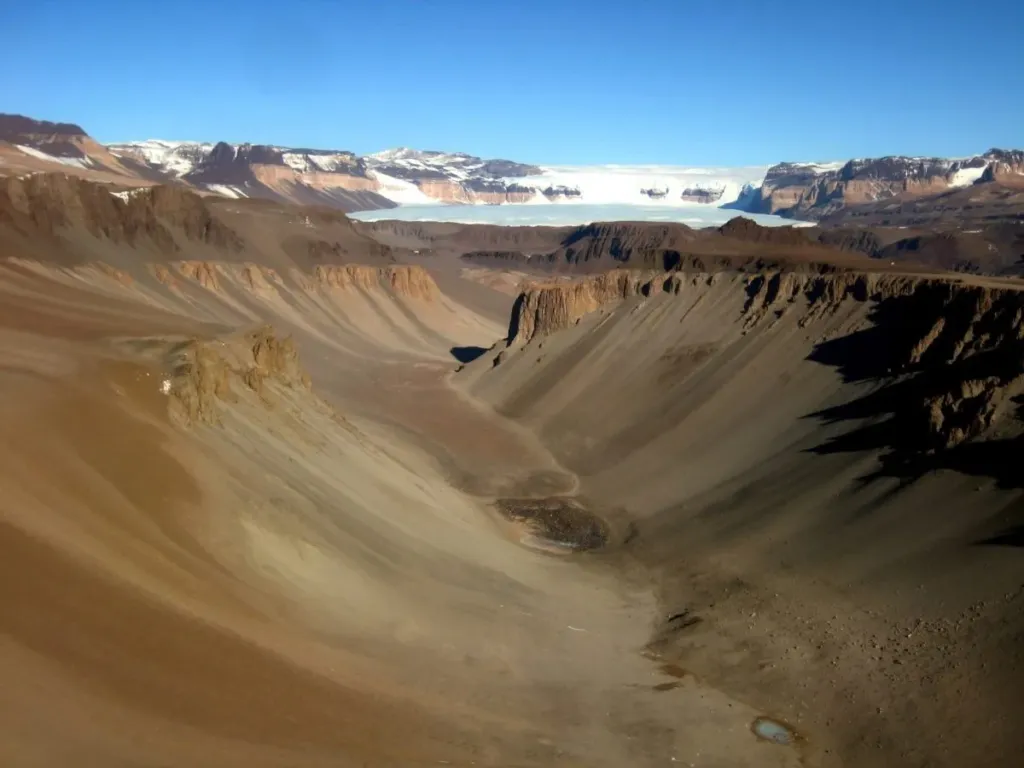Located in Victoria Land, this is the largest ice free area in Antarctica, covering about 4800 square kilometers. Unlike most of the continent, snow and ice are scarce due to ultra low humidity, minimal precipitation and strong katabatic winds that scour the surface and enhance sublimation. The landscape combines ancient bedrock, gravel pavements, towering glacier fronts and lakes capped by perennial ice. The area is organized around several main valleys, notably Taylor, Wright and Victoria, each hosting its own set of natural phenomena and unique ecosystems.
Detailed overview
The story begins in the heroic age of polar exploration. The British National Antarctic Expedition Discovery 1901–1904 led by Robert Falcon Scott brought the ice free valleys into scientific view. Geologist Hartley Ferrar mapped and described the bare ground, a striking anomaly in an otherwise icy continent. In the Terra Nova Expedition 1910–1913, geologist Griffith Taylor surveyed the valley that now bears his name and recorded the now famous outflow of brines known as Blood Falls. These milestones framed the big questions that still drive research today, from the absence of ice and the dynamics of downslope winds to the sources of brines and the limits of life.
In the second half of the twentieth century the region became a focal point for international science. Year round bases on nearby Ross Island, helicopter logistics and seasonal field camps enabled systematic observations. In the 1970s researchers described in detail the continent’s longest surface stream, the Onyx River, about 32 kilometers long, which flows for only a few weeks during peak summer melt. In the same era geochemical studies of Lakes Vanda and Bonney revealed stably stratified waters beneath clear multi year ice, with sharp gradients of temperature, salinity and oxygen. These waters mix very slowly, preserving signatures of climate and material transport across decades and centuries.
From the late 1980s and especially through the 1990s the McMurdo Dry Valleys LTER program emerged, coordinating long term measurements of atmosphere, cryosphere, geochemistry and biota. It has shown how rare events such as warm foehn winds or unusually sunny summers can reorganize lake biogeochemistry and boost microbial mat activity. Microbial communities have been found in lakes and subglacial brines, using chemical energy and surviving in cold and darkness. These discoveries directly support astrobiological hypotheses about potential life within cryospheres of other worlds, including transient brines on Mars and on icy moons.
Geomorphology records millions of years of Antarctic climate evolution. Ancient moraines, wind polished pavements, stone deserts with polygonal ground and rare rock benches shaped by past ice are all present. Katabatic winds descending from the ice sheet can reach hurricane force and are colder than ambient air, enhancing evaporation and ice sublimation. As a result, air humidity is near zero for much of the year and any fresh snow rapidly disappears.
Hydrology operates as a pulsed network. Surface flow appears in short bursts at the height of the austral summer under intense insolation. Small streams feed rivers like the Onyx, routing meltwater into the lakes. Subsurface brines such as those sourcing Blood Falls migrate through fractures and pore spaces, delivering iron, sulfates and other salts to the surface. Don Juan Pond in Wright Valley is famous for remaining liquid far below zero thanks to extreme salinity, becoming a natural lab for phase behavior and stability of brines.
The scientific significance reaches far beyond local geography. The valleys serve as a benchmark hyperarid cold desert where weathering without liquid water can be observed, surface energy balance can be measured and linkages among radiation, winds and rare thaw events can be traced to ecosystem responses. Long records from the LTER demonstrate that even small volumes of water can trigger cascading shifts in lake chemistry and microbial activity. Planetary science benefits from analogs to Mars where episodic brines and seasonal rills may have occurred. Paleoclimate studies value the signals archived in lake sediments. Microbiology uses the system as a model for survival under severe energy and water limitation.
The legal framework follows the Antarctic Treaty and the Protocol on Environmental Protection. Permits are required, strict biosecurity and minimal impact rules apply. Many sites fall within specially managed and specially protected areas, limiting non essential activity and preventing contamination. Tourism is rare and only possible through specialized programs with air support, since there are no roads and logistics depend entirely on weather and nearby station resources.
Interesting information
Blood Falls is red because dissolved iron in brines oxidizes upon contact with oxygen, while microbial communities use iron and sulfur as energy sources. Lake Vanda is known for unusual thermal stratification, with warmer and saltier deep waters beneath a cold ice cover. Many surface stones carry a dark desert varnish of manganese and iron oxides formed over very long timescales. The Onyx River flows inland rather than to the sea, from the glacier plateau toward the interior lakes of Wright Valley.
Facts and figures
Area about 4800 km². Length of the Onyx River about 32 km. Katabatic winds can reach 300 km per hour. Relative humidity near zero for much of the year. Don Juan Pond salinity above 40 percent by mass. Lake ice thickness often exceeds 3–4 meters while liquid water persists beneath. Summer solar radiation is very high under near continuous daylight.
Stories
Griffith Taylor wrote about the uncanny sight of bare ground amid Antarctic glaciers. Field teams in the 1970s recalled how a rare warm foehn could transform dry channels into rushing streams within days and raise lake levels noticeably. In the early 1990s the rise of the LTER network brought together geologists, biologists, chemists and meteorologists, fostering field schools where young researchers learned to collect clean samples in relentless dryness and wind.
Tourist sites
Blood Falls is a striking brine outflow from the Taylor Glacier that paints red streaks across white ice and showcases a rare interaction between brines and glacier ice. Don Juan Pond is a hypersaline pool in western Wright Valley demonstrating liquid stability under severe cold and minimal humidity. Lake Vanda is a deep basin capped by multi year ice with unique thermal stratification prized for its clear ice and scientific sampling. Lake Bonney is a two lobed lake in Taylor Valley where east and west basins differ in chemistry and ecosystems. The Onyx River is a seasonal flow that carves across Wright Valley and illustrates how a brief summer pulse can animate a hyperarid landscape. Ice slopes and dry channels in Taylor, Wright and Victoria Valleys are practical helicopter landing and short educational walk sites where visitors can see polygonal ground, stone pavements and wind scoured surfaces.
- Greece
- Panama
- 24 Facts About The Colosseum
- Global traveler risk ranking 2025
- Mongolia
- Derbent (Dagestan, Russia)
- Island
- Tourist places where Hemingway went
- The Driest Places on Earth: A Journey into the Realm of Aridity
- Reinhard Mey – Über den Wolken
- Pakistan
- Where to Find Gold in Nature
- In the footsteps of Pinocchio: a journey through the wooden boy’s world
- How to Get Around Australia
- Brest (Belarus)
- Great lakes
- Chukchi
- With a Movie Camera in Kamchatka
- About
- Kangaroo: interesting facts











